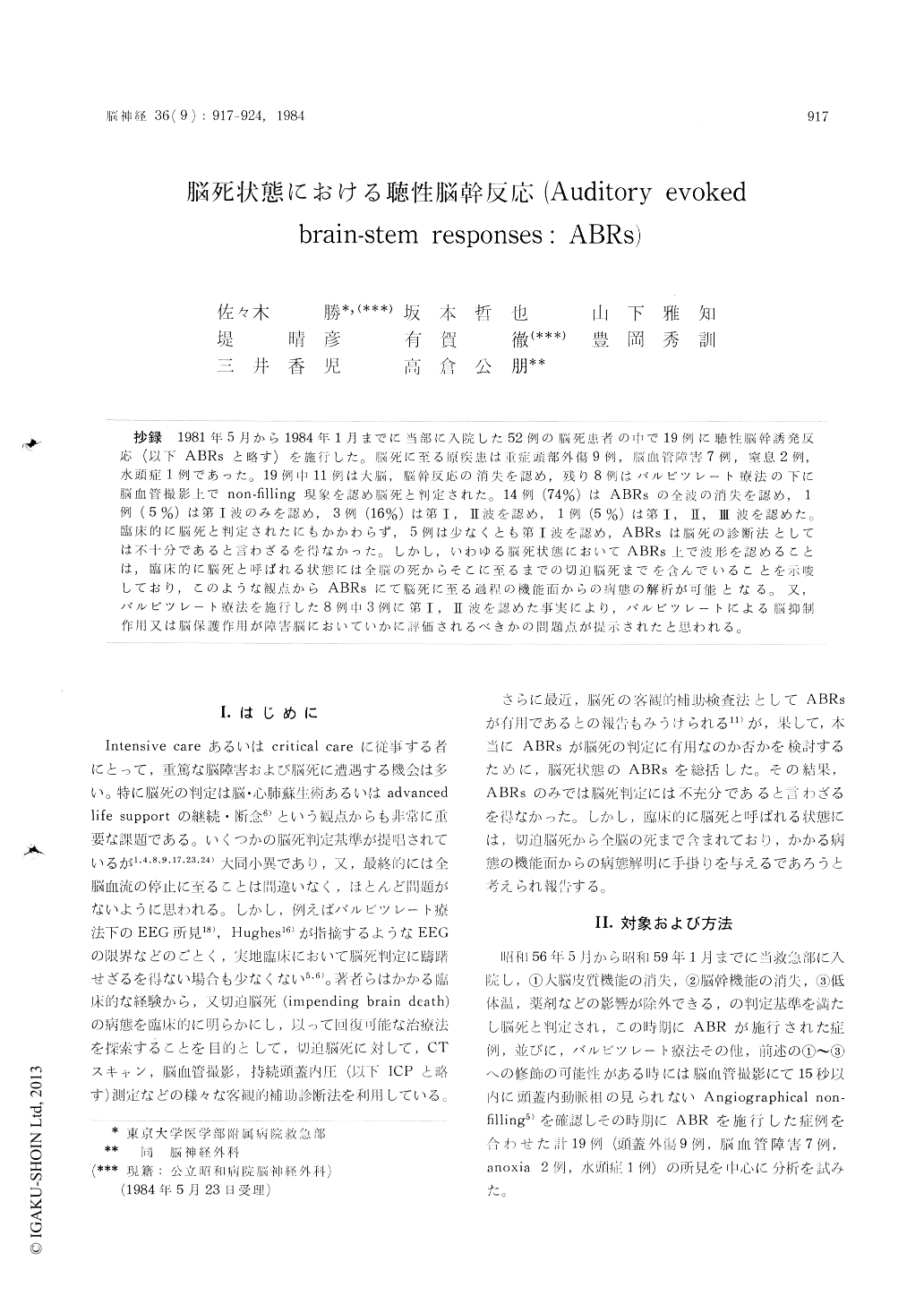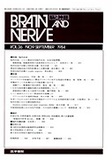Japanese
English
- 有料閲覧
- Abstract 文献概要
- 1ページ目 Look Inside
抄録 1981年5月から1984年1月までに当部に入院した52例の脳死患者の中で19例に聴性脳幹誘発反応(以下ABRsと略す)を施行した。脳死に至る原疾患は重症頭部外傷9例,脳血管障害7例,窒息2例水頭症1例であった。19例中11例は大脳,脳幹反応。)消失を認め,残り8例はバルビツレート療法の一下に脳血管撮影上でnon-filling現象を認め脳死と判定された。14例(74%)はABRsの全波の消失を認め,1例(5%)は第1波のみを認め,3例(16%)は第I,II波を認め,1例(5%)は第I,II,II波を認めた。臨床的に脳死と判定されたにもかかわらず,5例は少なくとも第1波を認め,ABRsは脳死の診断法としては不十分であると言わざるを得なかった。しかし,いわゆる脳死状態においてABRs上で波形を認めることは,臨床的に脳死と呼ばれる状態には全脳の死からそこに至るまでの切迫脳死までを含んでいることを示唆しており,このような観点からABRsにて脳死に至る過程の機能面からの病態の解析が可能となる。又,バルビツレート療法を施行した8例中3例に第I,II波を認めた事実により,バルビツレートによる脳抑制作用又は脳保護作用が障害脳においていかに評価されるべきかの問題点が提示されたと思われる。
Auditory evoked brain-stem responses (ABRs) were recorded in 19 out of 52 brain dead cases in Department of Emergency Medicine, University of Tokyo Hospital from May, 1981 to January, 1984. The causes of brain death were severe head injury (9 cases), cerebro-vascular disease (7 cases), anoxia (2 cases), hydrocephalus (1 case).
Eleven cases of them fulfilled the clinical criteria which included absense of cortical and brain-stemfunctions excluding severe hypothermia and de-pressant drug intoxication. The remainders who were subjected to barbiturate therapy were diag-nosed as brain death for non-filling phenomenon in cerebral angiography.
Results were as follows;
1) Fourteen cases (74%) had no identifiable ABR waves.
2) One case (5%) had only 1st wave.
3) Three cases (16%) had 1st and 2 nd waves.
4) One case (5%) had 1st, 2 nd, and 3rd waves. In spite of definition of clinical brain death, 5 cases had at least 1st wave, and therefore these datum suggested that ABR might have less clinical utility in diagnosis of brain death.
Each case did not necessarily demonstrate the total extinction of ABRs, as was shown in (2 ) to (4 ) mentioned above. The clinical status which met the criteria of brain death might therefore possibly imply any conditions in which brain death was impending gradually to result in thetotal brain death of cerebrum through medulla oblongata. Under these circumstances, how bar-biturate might produce ABRs abnormality re-mained unsolved, though it has been said not to produce ABRs abnormality. Among 8 cases under barbiturate therapy, there were 5 cases with no identifiable waves and 3 cases with 1st and 2 nd waves.
Whether under barbiturate therapy or not, ABRs proved to have less clinical utility in the decralation of brain death than expected. Such image diagnostic methods as computer tomography or cerebral angiography gave us useful comple-mentary information in the declaration of brain death and in making the analysis of its morpho-logical aspects. ABRs could be rather useful in the attempt to explore the functional aspects in impending brain death if monitored in automatic and serial way.

Copyright © 1984, Igaku-Shoin Ltd. All rights reserved.


